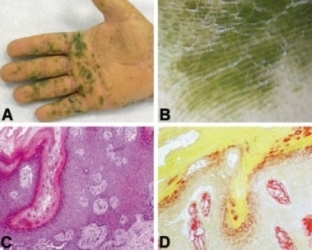Excessive sweating in itself is a good reason to visit a dermatologist or beautician. But if at the same time sweat stains clothes & nbsp; in red, blue or green, the patient is very frightened and assumes terrible diseases. It is, as a rule, a rare type of disease of the sweat glands. Chromhidrosis is explained by the synthesis in the patient's body of a specific pigment, lipofuchsin, which is secreted by the apocrine sweat glands and gives sweat a specific color. However, there may be other reasons why sweat can be multi-colored.
Why does chromhidrosis happen and what determines the color of sweat
The unusual color of sweat is often associated with its profuse secretion and unpleasant odor. Chromhidrosis has several causes of development:
- true chromhidrosis – a congenital defect in the sweat glands that secrete lipofucin, which can cause sweat to be blue, yellow, and even black;
- the professional activity of the patient when he works with some coloring chemicals that penetrate the body – cobalt, copper, pyrocatechins;
- reproduction of bacterial or fungal flora on the skin in violation of its hygiene – they produce a chromogen, which, when exposed to air, oxidizes and gives sweat a red, blue color.
Diagnosis and treatment of chromidrosis, getting rid of excessive sweating
 It is not difficult to diagnose chromhidrosis, assuming it already based on patients' complaints about linen and clothes stained with sweat. Staining occurs against the background of increased sweating and appears under the armpits, in the groin. The main thing in diagnostics – determine the reason why the sweat becomes multi-colored. Luminescent diagnostics, scraping for fungus, bakposev are used.
It is not difficult to diagnose chromhidrosis, assuming it already based on patients' complaints about linen and clothes stained with sweat. Staining occurs against the background of increased sweating and appears under the armpits, in the groin. The main thing in diagnostics – determine the reason why the sweat becomes multi-colored. Luminescent diagnostics, scraping for fungus, bakposev are used.
Hromhidrosis treatment is prescribed according to the cause that caused it. In parallel with cleansing the skin, procedures are prescribed that block strong sweating – for example, injections of botulinum toxin, which reduce the functionality of the sweat glands. If it doesn't help – sympathectomy is recommended for the patient.
If chromhidrosis is associated with the production of lipofuchsin, it is proposed to remove the sweat glands by laser or ultrasound, surgical excision. These measures may lead to complications in the form of compensatory hyperhidrosis.







Add a comment